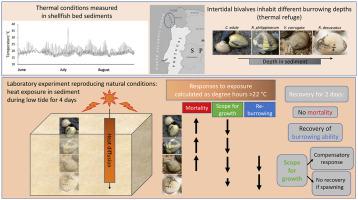Marine Environmental Research ( IF 3.0 ) Pub Date : 2020-12-03 , DOI: 10.1016/j.marenvres.2020.105229 Rula Domínguez , Celia Olabarria , Sarah A. Woodin , David S. Wethey , Laura G. Peteiro , Gonzalo Macho , Elsa Vázquez

|
Heat waves are expected to increase in duration and frequency, impacting coastal ecosystems, especially intertidal organisms living near their thermal tolerance limits. Sedentary infaunal species are limited to some extent in escapes from sudden temperature changes, rather modifications to their physiology and behaviour are expected. This may lead to strong ecological and economic impacts on commercial bivalve species, such as Venerupis corrugata, Ruditapes decussatus, the introduced Ruditapes philippinarum and Cerastoderma edule, the most relevant in NW Spain.
We investigated lethal and sublethal effects of heat during low tide on these species in the laboratory. Summer temperatures experienced within field, shallow sediments at approximately 2 cm depth i.e. 20 °C (control), 27 °C, 32 °C, and 37 °C, were replicated during four consecutive days and the diffusion of heat at the burrowing depth of each species was estimated; temperature exposure was expressed as degree hours above 22 °C. After two days of tidal exposure, C. edule and V. corrugata suffered significant mortalities, and also the most dramatic decrease in scope for growth (SFG) as well as reduction in burrowing activity. After four days under stress, all species had negative SFG. On recovery, species showed compensation at longer exposures, particularly C. edule. These effects of temperature on mortality, growth potential and burrowing ability may increase the time to achieve commercial size and exposure to predation. Particularly, V. corrugata, with a center of distribution lower in the intertidal and subtidal, and C. edule, shallower in the sediment, may be the most affected. Clearly the intensity and frequency of heat waves will affect these key species in the intertidal sediment flats changing ecosystem functioning and fisheries management strategies.
中文翻译:

四个具有重要生态和经济意义的双壳类动物对模拟热浪的响应能力对比
预计热浪的持续时间和频率将增加,从而影响沿海生态系统,特别是生活在其热耐受极限附近的潮间带生物。久坐的不育物种在一定程度上受到温度突然变化的影响,因此有望改变其生理和行为。这可能导致商业双壳贝类,如强大的生态和经济影响蛤仔corrugata,蛤仔,引入菲律宾蛤仔和Cerastoderma edule,在NW西班牙最相关的。
我们在实验室中研究了退潮期间热量对这些物种的致死和亚致死作用。在田间经历的夏季温度,在连续4天中复制了大约2 cm深度(即20°C(对照),27°C,32°C和37°C)的浅层沉积物,并且在地下深度挖出了热量估计每个物种;温度暴露表示为高于22°C的度数小时。潮汐暴露两天后,小菜蛾和皱纹狐狸的死亡率显着降低,而且生长范围(SFG)的下降幅度最大,洞穴活动减少。在胁迫下四天后,所有物种的SFG均为阴性。恢复时,物种在更长的暴露时间内表现出补偿,尤其是淡水梭菌。温度对死亡率,生长潜力和挖掘能力的这些影响可能会增加达到商业规模和暴露于捕食的时间。特别是,在潮间带和潮下带分布中心较低的皱纹葡萄(V. corrugata)和在沉积物中较浅的淡色弯曲藻(C. edule)可能受到的影响最大。显然,热浪的强度和频率将影响潮间带沉积物中这些关键物种,从而改变生态系统功能和渔业管理策略。











































 京公网安备 11010802027423号
京公网安备 11010802027423号